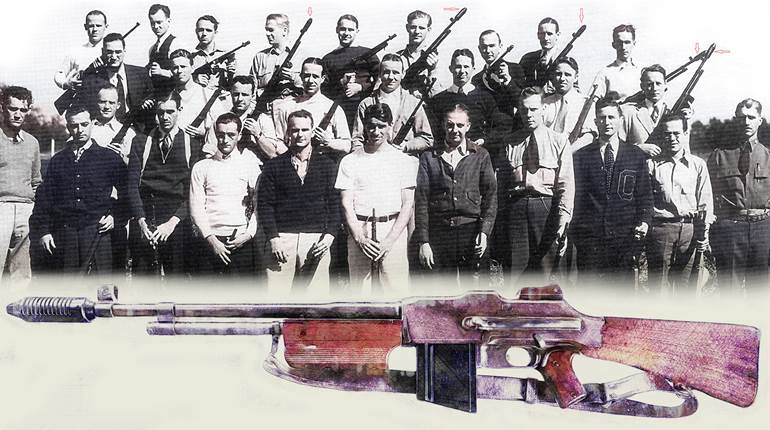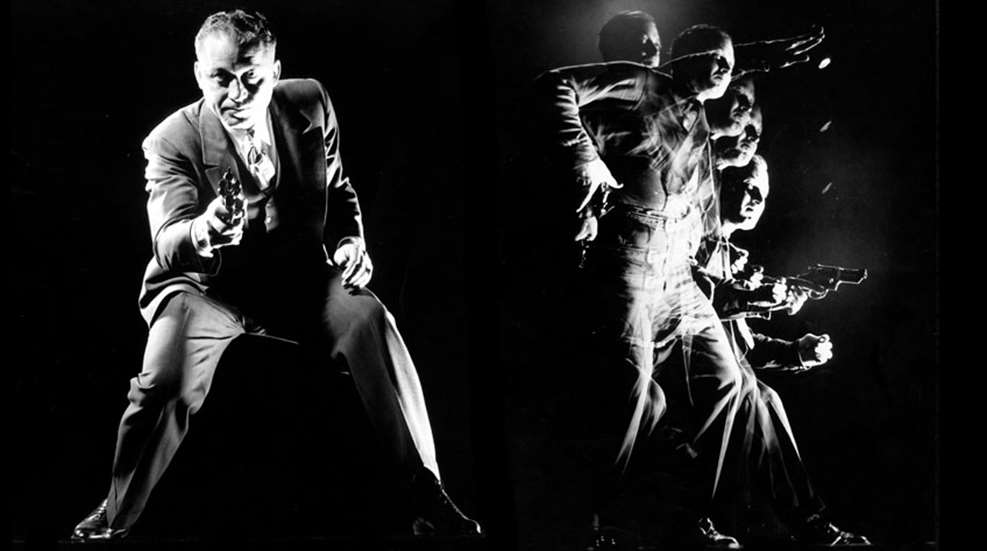
(l.) Jelly Bryce had his own point-shooting method. Taken for dramatic effect for LIFE (and as we know, in clear violation of NRA safety rules) this image clearly demonstrated Bryce’s unique, deep crouch stance. He would fire when the gun came level with the target. (r.) A stroboscopic image of FBI agent Delf Bryce drawing his gun. In this demonstration, Bryce flips a poker chip, draws his gun and shoots the chip before it hits the ground.
On a cold and foggy morning in 1933, a group of lawmen quietly surrounded a small frame house in Shawnee, Okla. Inside was one Wilbur Underhill, Jr., called the Tri-State Terror, wanted for eight murders, nine bank robberies and four escapes from various state penitentiaries. His most recent crime spree had started earlier in the year when he left the Kansas state pen without proper permission. To say that Underhill was armed and dangerous would have been a serious understatement.
Once the officers were in place, one eased up to a bedroom window to have a look. The look he got was Wilbur Underhill staring straight at him, armed with a pair of German Lugers. The fight was on. As Underhill blazed away with his pistols, the lawmen hosed the house down with shotguns and Thompson submachine guns. In a surprise move, Underhill burst from the front door of the house and ran off into the fog. Underhill’s freedom was, however, short-lived. He was found a few blocks away, hiding in a furniture store and bleeding from numerous gunshot wounds. Amazingly, it took the outlaw six days to expire.
One of the officers involved in the shootout was a young native Oklahoman named Delf Bryce. Bryce would go on to make quite a name for himself in law enforcement circles around the country. A snappy dresser and quick with any kind of gun, Bryce would be better known as “Jelly” Bryce.
Delf A. Bryce was born in December of 1906, at Mountain View, Oklahoma Territory. Although he participated in school sports, his real love was firearms. At a very early age, armed with his trusty .22 rifle, Bryce began to attract attention with his marksmanship simply because he rarely missed what he was shooting at. One suspects that Bryce, like Bill Jordan and Ad Toepperwein, must have been born with superior hand/eye coordination. And his love of guns—and his continual practice—honed these skills throughout his lifetime.
By 1927, Bryce had decided that a career in law enforcement was for him. In that year he signed on as an Oklahoma game warden. It was also about that time that Bryce began to compete in area pistol matches. Some of these matches, run by police agencies, were bullseye competition, while others were of the turkey-shoot variety. Regardless, Bryce didn’t always bring home the blue ribbon, but he always did very well. So well, in fact, that he soon caught the eye of some of the top shooters from the Oklahoma City Police Dept.
In 1928, Bryce was hired by OKCPD as a detective, and, of course, quickly earned a spot on the department’s pistol team. It was also about this time that Bryce got the nickname “Jelly.” You see, back in those days a fancy dresser was often called a “jellybean,” and Bryce always wore sharp clothes. Another version of how he received his nickname has Bryce wounding a car thief who exclaimed, “Please don’t tell them I got shot by a jellybean!”
Working with a series of detective partners, Jelly Bryce had quite a few adventures with the various criminals that hung out in wide-open Oklahoma City. Although a lot of myths exist about Jelly Bryce, there is no doubt that he was involved in his share of shootings and car chases where the crooks swapped shots with the lawman.
One such shootout occurred at an Oklahoma City hotel in 1934. A policeman told Bryce and his partner that he was pretty sure he had seen Harvey Pugh going into the hotel. Pugh was a wanted man who was believed to associate with Clyde Barrow and Bonnie Parker—the infamous “Bonnie and Clyde.”
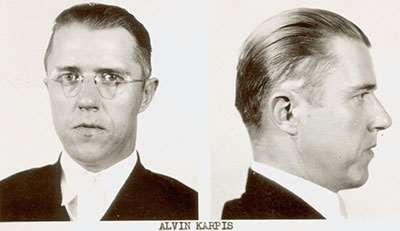
The two detectives got the hotel manager to bring a key and open Pugh’s room. As the manager opened the door and stepped back, Bryce saw a man lying on a bed and pointing a pistol at him. Dropping into a crouch, Bryce drew his revolver and fired five quick shots. The crook, a gangster friend of Pugh’s, never got off a shot. Again, stories vary, but some will tell you that all five of Bryce’s shots took effect inside the outlaw’s head, while another source says that four were hits and the fifth shot went wild. It probably didn’t matter to the dead outlaw.
Jelly Bryce was a point shooter and, like all of the good point shooters, he had his own style. Bill Jordan preferred to stand erect and only move the arm and shoulder necessary to making his draw and getting his shot off. Rex Applegate, on the other hand, used a slight crouch and fully extended his shooting arm.
Jelly Bryce had developed a very deep crouch, and he shot as soon as his gun came level with the target. Like Bill Jordan, Bryce used a circular motion to effect his draw, sweeping his hand below the gun butt and snatching the pistol as his hand came up and over the gun butt. At this late date, we don’t know for sure, but most historians believe that Bryce used a holster of the Threepersons design as built by S.D. Myres, George Lawrence or A.W. Brill.
During his tenure at OKCPD, Jelly Bryce favored a Smith & Wesson 3rd Model Hand Ejector, in .44 Spl. The sixgun had fixed sights and a 4" barrel. In addition, it was nickel-plated and nicely engraved, and had ivory stocks. On the right stock panel was a carved steer head, while on the left was a black cat and the number “13.” Not the superstitious type, Bryce claimed that the only bad luck his gun would bring would be to criminals. And, thinking to expand his area of criminal hunting, Jelly Bryce had his eye on the Federal Bureau of Investigation.
By the 1930s, J. Edgar Hoover had just about cleaned out his adopted agency of bums, political appointees and some downright crooks. He had begun a policy of requiring his FBI agents to be of good character and have college degrees in either accounting or the law. But he began to run into trouble when he found out that these college graduates were poorly equipped to deal with the likes of John Dillinger, Pretty Boy Floyd and Baby Face Nelson.
In fact, things were getting downright embarrassing. Poorly planned raids were letting the crooks get away and the honest citizens get shot up. The gangsters were making the FBI look like fools.
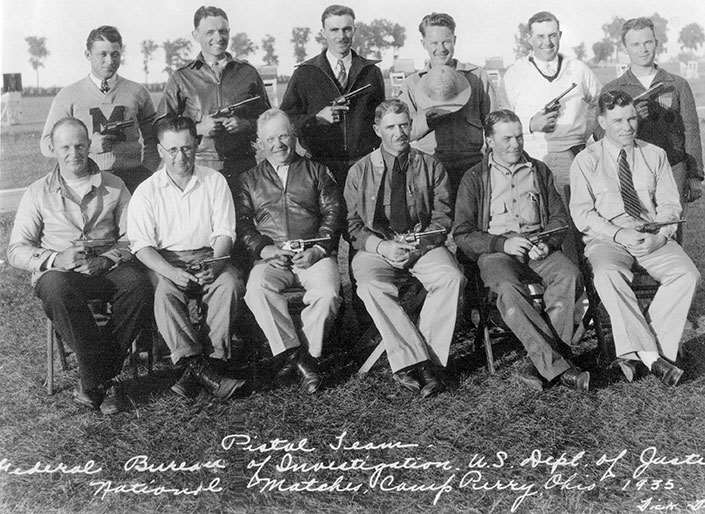
Suddenly, and quietly, the college requirement was being dropped in the case of many applicants. In short, Hoover began to recruit a team of shooters to his department. He enlisted a Texas deputy sheriff named Charles Winstead (who would later kill John Dillinger), Texas Rangers Gus Jones and Doc White, and OKC police detectives Clarence Hurt and Jerry Campbell. And, in November of 1934, he signed up Jelly Bryce.
Unfortunately, much of Bryce’s early FBI record has either been lost or destroyed. We do know that he was probably still in training when Dillinger went down in Chicago. And, of course, there was no FBI agent present when Bonnie and Clyde met their fate on that dusty road in Louisiana. But it is possible that he helped write the end to the Barker Gang.
Ma Barker and her sons had hooked up with Alvin Karpis to pull a number of bank robberies around the country. The gang had even branched out into kidnappings. One by one, members of the gang were either captured or shot down until Freddie Barker, Ma Barker and Alvin Karpis were the only ones left.
Early in 1935, the FBI developed information that Ma and Freddie were hiding out in a house near Lake Weir, Fla. Agents surrounded the house, and a four-hour gun battle ensued. The result was that the house was shot up and both of the Barkers were killed. Karpis, though not with the Barkers at the time of the shooting, was captured a short time later.
It was at about this time that Jelly Bryce obtained another handgun. In 1935, the .357 Magnum cartridge was introduced and touted as the perfect round for law enforcement due to its extra power (early loadings drove a 158-gr. bullet at some 1500 f.p.s.). At about the same time, Smith & Wesson brought out the .357 Magnum revolver, later to be called the Model 27. This big N-frame revolver easily handled the pressure and velocity of the new cartridge and was the same size as Bryce’s .44 Spl. sixgun.
One of the first S&W magnums was presented to J. Edgar Hoover, and the model quickly became popular with his agents. Bryce, apparently, chose the model with the 3½" barrel. Later photos show him demonstrating his fast draw with this gun, and it may well have replaced his old .44.
Jelly Bryce was also a fan of the sawed-off shotgun, and favored various Remington pumps. He said that he liked pumps because he could run the action faster than a semi-automatic shotgun could cycle. And, in later shooting exhibitions, he demonstrated just that. In fact, throughout his life, Jelly Bryce would continue to keep a shotgun close at hand, carrying one in his car long after he had turned in his badge.
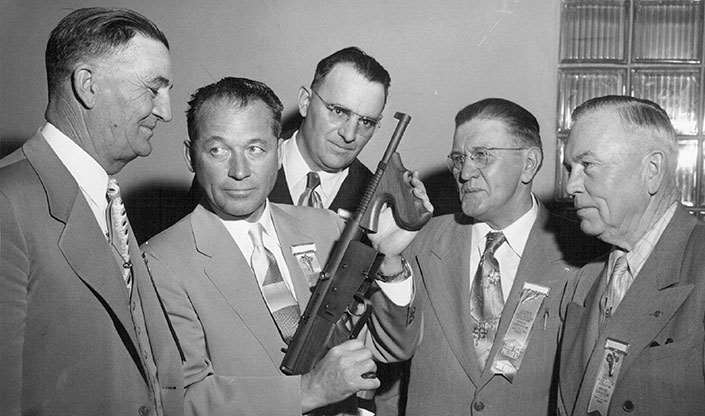
Despite his reputation as a gunfighter, Jelly Bryce was known to most citizens through the shooting exhibitions that he put on around the country. Clearly, J. Edgar Hoover thought that having an FBI agent give shooting demonstrations was good publicity for the department. And none of the other agents could do it quite as well as Jelly Bryce.
Bryce used rifles, pistols and shotguns in his demonstrations. He used all three to shoot various aerial targets as small as grapes, pecans and coins. He would hit stationary targets while holding his revolver upside down. He would even turn his back on a target, bend over and shoot between his own legs. Another gag was to turn his back on the target and shoot the revolver over his left shoulder while seeing the sights in the reflection of the big diamond ring that he wore.
And, of course, a Jelly Bryce shooting demonstration would not have been complete without him showing off his fast draw. He would tell people to clap their hands when they saw him move and, when their hands came together, it was around the barrel of Bryce’s (unloaded) gun. Another fast-draw stunt that he performed was called “the poker chip draw.” Holding his gun hand parallel to the ground, Bryce would place a poker chip on the back of his hand. When he moved his hand, the chip would begin to fall and Bryce would sweep his coat out of the way, draw his revolver and get off a double-action shot before the chip hit the ground. About 1945, LIFE Magazine published photos of Bryce doing this very thing.
Of course, there are some who claim that Jelly Bryce would shoot the poker chip as it fell. But this is so unsafe as to be doubtful. No one wants to shoot that close to his own legs, knees and feet. And, speaking of unsafe, many of the old exhibition stunts that Bryce used to attempt are no longer considered safe to perform. Shooting rifles and handguns at aerial targets brings to question when and where, exactly, that bullet is going to land. Nor is it considered proper to point guns, even unloaded guns, at your audience or anyone else. For all of that, Jelly Bryce was a man of his times, and received many commendations for the good public relations that resulted from his shooting exhibitions.
One of the interesting things about Bryce’s FBI career was the strong friendship that developed with J. Edgar Hoover. The cosmopolitan bureaucrat and the Oklahoma farm boy really hit it off. Most FBI agents spend an entire career with few promotions. But, by 1941, Jelly Bryce was the special agent in charge of the El Paso field office. He later filled the top slot in San Antonio, Texas, and finally, in 1945, was promoted to special agent in charge of the state of Oklahoma, with offices at Oklahoma City. Clearly, Hoover felt that Jelly Bryce was a man who could take care of business. Bryce finally retired from the FBI in 1958 and passed away in 1974 of natural causes.
Like most Oklahoma, Texas and Southwest lawmen, Jelly Bryce did not like to give interviews and refused to talk about the people that he had killed. By all accounts, he liked to tell stories when visiting with friends, but killings were not among the topics that he considered suitable. We do know that Jelly Bryce saw more than his share of dangerous situations, many of them ending in gunfire. He was a lawman who could match it with just about any of the 1930s gangsters and he could also please a crowd with his expert marksmanship.
Above all, he was a “jellybean” who could shoot!












